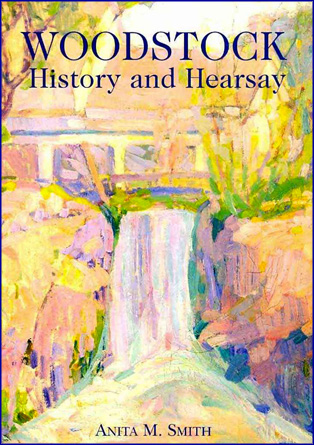Woodstock History and Hearsay
By Anita M. Smith
- Winner of 2007 Independent Publisher Book Award in U.S. Northeast best regional non-fiction
- Winner of the National Best Books 2007 Award in creative non-fiction
- Finalist for 2006 ForeWord Book of the Year Award in regional (adult non-fiction) category
Anita M. Smith’s Woodstock History and Hearsay begins with the indigenous god Manitou sending down from the sky the first woman in the shape of a tortoise. Overlook Mountain, which dominates the Woodstock valley, was regarded by Native Americans as the home of Manitou, and is considered sacred ground. Smith’s narrative continues with the arrival of the early European settlers. Her account of the Revolutionary War days balances the viewpoints and activities of local Whigs, Tories and Native Americans. The latter include the exploits of Mohawk chief Joseph Brant. By the start of the 1800s the Industrial Revolution was mobilizing the valley. The principal activities were glass making, tanning and farming. Soon thereafter the area was ablaze with the farmers’ rebellion against the landlords in the tumultuous Down-Rent War.
Founding of the Woodstock Art Colonies
Smith provides a compelling portrait of Ralph Radcliffe Whitehead, a disciple of John Ruskin and William Morris. In 1902 Whitehead launched the Byrdcliffe Arts and Crafts Colony in Woodstock. He sought to challenge the mechanistic age by reviving the ancient handicrafts of weaving, ironwork, furniture making and pottery. He wanted artisans to celebrate these crafts in a place that was healthful for their minds as well as their bodies. Co-founders of his utopian venture were Bolton Brown and a Whitmanesque Midwesterner, Hervey White. Anita Smith, who arrived in the fledgling colony in 1912 as a painter, evokes the magic of this time through a melding of personal anecdotes and scholarship.
As Smith relates in Woodstock History and Hearsay, Hervey White went on to found the Maverick, a commune and second art colony, just over the Woodstock town line in West Hurley. Here he sponsored a theater and a program of summer chamber music. (The Maverick Concerts are the oldest continuous series in the United States today). White also founded the Maverick Festival, a forerunner of the world-famous Woodstock Festival of 1969.
Soon countless numbers of distinguished American painters, sculptors, musicians, writers, dancers, poets and other artists took up residence in Woodstock: George Bellows, Yasuo Kuniyoshi, Philip Guston, Alexander Archipenko, Pierre Henrotte, Georges Barrère, James T. Shotwell, Henry Morton Robinson, Bliss Carman, Helen Hayes, Maud and Miska Petersham, Wilna Hervey and Nan Mason, and a host of others. With her artistic eye, Anita Smith weaves a rich tapestry of oral and documented lore to capture the byplay between hardworking farmers and businessmen, shape-shifting witches and bohemian artists, providing a wonderful behind-the-scenes view of pre-1969 Festival Woodstock.
More About Woodstock History and Hearsay
Published 2006; second edition; ISBN 9780967926841; hard cover/cloth; 8½ x 11 inches; 335 pages, 170 black and white photos; two color inserts with 19 color images. Front matter: list of maps (7), preface, acknowledgments, AMS biographical timeline and introduction. Back matter: Woodstockers in Service (Second World War and Memoria), end notes, bibliography, list of illustrations and index.
List price: $37.50 / sale price on this site: $30.00; shipping within U.S. only.
About the Author
Anita M. Smith (1893–1968) was born a Quaker in Philadelphia. In 1912 she moved to Woodstock to study painting under John F. Carlson. Soon she was exhibiting her work at the National Academy of Design, the Art Institute of Chicago and the Pennsylvania Academy of the Fine Arts. In 1934 she built a bluestone house near Woodstock’s Rock City corners and embarked on a second career as a herbalist. By 1940 Smith had customers in all forty-eight of the contiguous United States, and in a New York Herald Tribune article published that year she was referred to as “the Herb Lady of the Catskills.”
During this time she began contributing papers to the Historical Society of Woodstock. Just as she had designed her gardens with an artist’s eye, Smith captured the painter’s feel for the landscape in her writing. In the late 1950s she wrote the town’s first official history. A blend of local legends, personal anecdotes and scholarship, Woodstock History and Hearsay was first published in 1959. Anita Smith also wrote As True as the Barnacle Tree, The Landscape of History and The Quest of Abel Knight: The Quakers and Shakers.


[…] history of Woodstock, NY based on Woodstock History and Hearsay by Anita M. […]
[…] garnered press in publications such as the New York Herald Tribune. Today she is well known for her Woodstock History and Hearsay (first published in 1959; second edition released by WoodstockArts in 2006), and her numerous […]
[…] garnered press in publications such as the New York Herald Tribune. Today she is well known for her Woodstock History and Hearsay (first published in 1959; second edition released by WoodstockArts in 2006), and her numerous […]